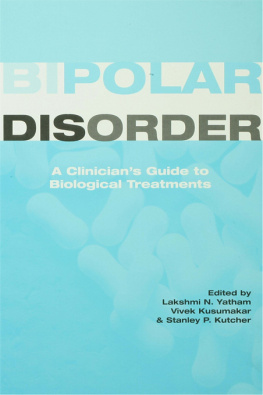
_________________
BIPOLAR DISORDER
_________________
_________________________________________________
BIPOLAR DISORDER
A Clinicians Guide to Biological Treatments
_________________________________________________
Edited by
LAKSHMI N. YATHAM
VIVEK KUSUMAKAR
STANLEY P. KUTCHER

Published in 2002 by
Brunner-Routledge
29 West 35th Street
New York, NY 10001
Published in Great Britain by
Brunner-Routledge
27 Church Road
Hove, East Sussex, BN3 2FA
Brunner-Routledge is an imprint of the Taylor & Francis Group.
Copyright 2002 by Brunner-Routledge.
Printed in the United States of America on acid-free paper.
Cover design: Pearl Chang
All rights reserved. No part of this book may be reprinted or reproduced or utilzed in any form or by any electronic, mechanical, or other means, now known or hereafter invented, including photocopying and recording or in any information storage or retrieval system, without permission in writing from the publisher.
10 9 8 7 6 5 4 3
Library of Congress Cataloging-in-Publication Data
Bipolar disorder : a clinicians guide to biological treatments / [edited] by Lakshmi N. Yatham, Vivek Kusumakar, and Stanley P. Kutcher.
p. : cm.
Includes bibliographical references and index.
ISBN 0415933900
1. Manic-depressive illnessChemotherapy. 2. Depression, MentalChemotherapy. 3. Neuropsychopharmacology. 4. Manic-depressive illnessTreatment. I. Yatham, Lakshmi N. II. Kutcher, Stanley P. III. Kusumakar, Vivek.
[DNLM: 1. Bipolar Disorderdrug therapy. 2. Tranquilizing Agentstherapeutic use.
WM 207 B6157 2002]
RC516 .B5246 2002
616.895061dc21
2002018282
Contents
.
Contributors
Charles L. Bowden, M.D.,
Karren Professor and Chairman,
Department of Psychiatry,
University of Texas Health Science Center,
San Antonio, Texas
K. N. Roy Chengappa, M.D.,
Associate Professor of Psychiatry,
Western Psychiatric Institute & Clinic,
University of Pittsburgh Medical Center,
Special Studies Center at Mayview State Hospital,
Stanley Center for the Innovative Treatment of Bipolar Disorder
William H. Coryell, M.D.,
Professor of Psychiatry,
Psychiatry ResearchMEB,
College of Medicine,
University of Iowa
A. Eden Evins, M.D.,
Instructor in Psychiatry,
Harvard Medical School,
Co-Director, Schizophrenia Research Program,
Massachusetts General Hospital, Boston
Samuel Gershon, M.D.,
Professor of Psychiatry,
Western Psychiatric Institute & Clinic,
University of Pittsburgh Medical Center,
Stanley Center for the Innovative Treatment of Bipolar Disorder,
Pittsburgh
A. Dooley Goumeniouk, M.D.,
Clinical Associate Professor,
Department of Psychiatry,
The University of British Columbia,
Vancouver
Paul E. Keck, Jr., M.D.,
Biological Psychiatry Program,
Department of Psychiatry,
University of Cincinnati College of Medicine,
Cincinnati, Ohio
Terence A. Ketter, M.D., F.R.C.P(C),
Chief, Bipolar Disorders Clinic,
Department of Psychiatry and Behavioral Sciences,
Stanford University of Medicine, Stanford, California
Vivek Kusumakar, M.D., F.R.C.P.C.
Associate Professor of Psychiatry,
Director, Stanley International Centre for the Study of Bipolar Disorder,
Dalhousie University, Halifax, Nova Scotia
Stanley P. Kutcher, M.D., F.R.C.P.C.,
Professor and Head, Department of Psychiatry,
Dalhousie University,
Halifax, Nova Scotia
Raymond W. Lam, M.D.,
Professor of Psychiatry, University of British Columbia,
Medical Director, Mood Disorders Clinic, UBC Hospital
Vancouver
Joseph Levine, M.D.,
Visiting Faculty,
Western Psychiatric Institute & Clinic,
University of Pittsburgh Medical Center,
Special Studies Center at Mayview State Hospital,
Stanley Center for the Innovative Treatment of Bipolar Disorder,
Pittsburgh
Xiaohua Li, M.D., Ph,D.,
Department of Psychiatry and Behavioral Neurobiology,
University of Alabama at Birmingham
Frank P. McMaster, Research Associate,
Mood Disorders Group,
Dalhousie University,
The I.W.K. Grace Health Centre,
Halifax, Nova Scotia
Frank P. MacMaster,
Research Associate,
Mood Disorders Group,
Dalhousie University,
The I.W.K. Grace Health Centre,
Halifax, Nova Scotia
Susan L. McElroy, M.D.,
Professor of Psychiatry,
Biological Psychiatry Program,
Department of Psychiatry,
University of Cincinnati College of Medicine,
Cincinnati, Ohio
Roy H. Perlis, M.D.,
Psychopharmacology Chief Resident,
Massachusetts General Hospital,
Boston, MA 02115
Clinical Fellow in Psychiatry,
Harvard Medical School
Gary S. Sachs, M.D.,
Assistant Professor of Psychiatry,
Department of Psychiatry,
Massachusetts General Hospital, Boston
Karen Saperson, M.B., Ch.B.,
Assistant Professor of Psychiatry,
Department of Psychiatry,
McMaster University,
Hamilton, Ontario
Kenneth I. Shulman, M.D., S.M.,
Professor of Psychiaty,
Department of Psychiatry,
University of Toronto
Jair C. Soares, M.D.,
Western Psychiatric Institute & Clinic,
University of Pittsburgh Medical Center,
Stanley Center for the Innovative Treatment of Bipolar Disorder,
Pittsburgh
Mauricio F. Tohen, M.D.,
Professor of Psychiatry
Associate Clinical Professor of Psychiatry,
Lilly Research Laboratories,
Indianapolis, Indiana,
Harvard Medical School
Po W. Wang, M.D.,
Department of Psychiatry and Behavioral Sciences,
Stanford University of Medicine,
Stanford, California
Lakshmi N. Yatham, M.B., F.R.C.P.C.
Associate Professor of Psychiatry,
Division of Mood Disorders, University of British Columbia,
Director, Mood Disorders Clinical Research Unit, UBC Hospital,
Vancouver Hospital and Health Sciences Centre
L. Trevor Young, M.D., Ph.D.,
Associate Professor,
McMaster University,
Department of Psychiatry,
Hamilton, Ontario
Carlos A. Zarate, Jr., M.D.,
Chief, Mood Disorders Research Unit,
Assoc. Clinical Director, Laboratory of Molecular Pathophysiology,
Mood and Anxieties Disorders Program,
National Institute of Mental Health,
Bethesda, MD
Anthanasios P. Zis, M.D.,
Professor and Head,
Department of Psychiatry,
The University of British Columbia,
Vancouver
Preface
Bipolar Disorder affects at least 1.6% of the population and is the sixth leading cause of disability. The discovery of lithium offered the hope that this condition could be treated effectively. This has been true for bipolar I, classical, episodic disorder, but as our understanding of the heterogenous manifestations of this disorder have increased, clinicians have realized that lithium is not a panacea for bipolar disorder. The recognition that carbamazepine and, later, valproate, have mood modulating properties opened the door to a new era. This happened even as traditional treatment with neuroleptics of mania continued. With the advent of a new generation of anticonvulsants and atypical neuroleptics, there has been a resurgence of interest in the pharmacological treatment of bipolar disorder, with a continuing search for the ideal mood stabilizer that is effective both in acute phases of a mood disorder and for prophylaxis. Thus, the clinician is faced with making choices from a variety of medications.
Next page








